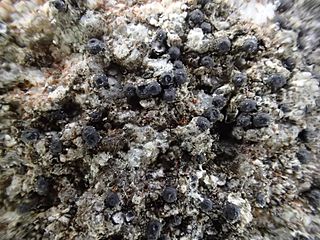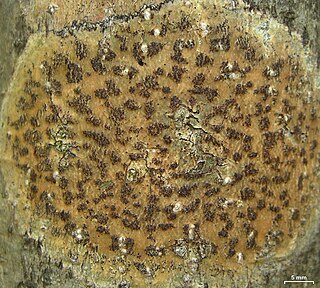
The Monoblastiaceae are a family of lichen-forming fungi in the monotypic order Monoblastiales. It contains six genera. The family was circumscribed in 1929 by British botanist William Watson.

Sarcographa is a genus of lichen-forming fungi in the family Graphidaceae. It is estimated to contain 37 species. The genus was circumscribed by French botanist Antoine Laurent Apollinaire Fée in 1825.
Trichothelium is a genus of lichen-forming fungi in the family Trichotheliaceae. It has an estimated 40 species. The genus was circumscribed by Swiss lichenologist Johannes Müller Argoviensis in 1885.

Calopadia is a genus of foliicolous (leaf-dwelling) lichens in the family Pilocarpaceae. It was circumscribed by Czech lichenologist Antonín Vězda in 1986.
Sporopodium is a genus of lichen-forming fungi in the family Pilocarpaceae.

Mazosia is a genus of lichen-forming fungi in the family Roccellaceae. The genus was circumscribed by Italian lichenologist Abramo Bartolommeo Massalongo in 1854.

Lecanactis is a genus of crustose lichens, commonly called old wood rimmed lichen. The genus was circumscribed in 1855 by German lichenologist Gustav Wilhelm Körber, who assigned Lecanactis abietina as the type species.

Syncesia is a genus of lichen-forming fungi in the family Roccellaceae.
Lyromma is a genus of foliicolous (leaf-dwelling) lichens, and the sole member of Lyrommataceae, a family in the order Chaetothyriales. The genus was circumscribed in 1965 by Brazilian mycologists Augusto Chaves Batista and Heraldo da Silva Maia, with Lyromma nectandrae assigned as the type species. The family was proposed by Robert Lücking in 2008. Characteristics of the genus include the spherical to short barrel-shaped perithecia and elongated barrel-shaped pycnidia, and smooth thalli of rounded patches formed by its symbiotic relationship with green algae from the genus Phycopeltis.

Nyungwea is a genus of lichen-forming fungi in the family Opegraphaceae. It was circumscribed in 2006 by Emmanuël Sérusiaux, Eberhard Fischer, and Dorothee Killmann, with Nyungwea pallida assigned as the type species.
Aderkomyces is a genus of lichens in the family Gomphillaceae. It was circumscribed by Brazilian mycologist Augusto Chaves Batista in 1961.

Architrypethelium is a genus of lichen-forming fungi in the family Trypetheliaceae.
Pseudopyrenula is a genus of lichen-forming fungi in the family Trypetheliaceae.

Malmideaceae is a family of crustose and corticolous lichens in the order Lecanorales. It contains eight genera and about 70 species.

Lichenoconium is a genus of fungi belonging to the family Lichenoconiaceae.
Eugeniella is a genus of mostly leaf-dwelling (foliicolous) lichens in the family Pilocarpaceae. It contains 13 species. The genus was circumscribed in 2008 by lichenologists Robert Lücking, Emmanuël Sérusiaux, and Klaus Kalb, with Eugeniella psychotriae assigned as the type species. This lichen was originally called Patellaria psychotriae by Johannes Müller Argoviensis in 1881. The seven species that were initially included in the genus had previously been placed in the genera Bacidia and Byssoloma. Several newly identified species from Australasia and Central and South America were later added. Most of the species grow on leaves, although four of the Australasian species grow on bark.

Viridothelium is a genus of lichen-forming fungi in the family Trypetheliaceae. It has 11 species. The genus was circumscribed by Robert Lücking Matthew Nelsen, and André Aptroot in 2016, with Viridothelium virens assigned as the type species. Lichens in this genus were previously assigned to genus Trypethelium, as part of the Trypethelium virens clade.
Caprettia lichexanthotricha is a species of lichen in the family Monoblastiaceae. Found in Brazil, it was formally described as a new species in 2021 by lichenologists André Aptroot and Maria Fernanda de Souza. The type specimen was collected by the authors from Tagaçaba ; here the lichen was found growing on tree bark. It has a dull, pale greenish-grey thallus that covers an area up to 10 cm (4 in). The photobiont partner of the lichen is trentepohloid, and in some parts of the thallus the resident algae partly escape and become filamentous. The thallus fluoresces a patchy yellow when shone with a UV light, due to the presence of lichexanthone, a secondary chemical for which the lichen is named. Caprettia lichexanthotricha is the only species in genus Caprettia that has lichexanthone.

Robert Lücking is a German lichenologist. He earned his master's and PhD from the University of Ulm, focusing on the taxonomy, ecology, and biodiversity of foliicolous lichens. He has received numerous awards for his work, including the Mason E. Hale Award for his doctoral thesis, the Augustin Pyramus de Candolle prize for his monograph, and the Tuckerman Award twice for his publications in The Bryologist. Since 2015, he has been serving as the curator of lichens, fungi, and bryophytes at the Berlin Botanical Garden and Botanical Museum, and several lichen species and a genus have been named in his honour.
Aspidothelium is a genus of lichen-forming fungi in the family Thelenellaceae. All species in the genus have a tropical distribution and are crustose with a chlorococcoid photobiont partner. Most Aspidothelium species are foliicolous (leaf-dwelling), although some corticolous (bark-dwelling) species are known, as well as a single saxicolous (rock-dwelling) member.











